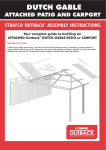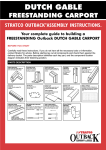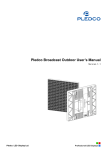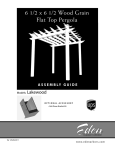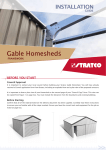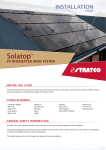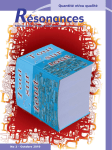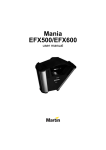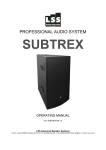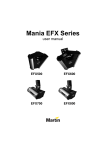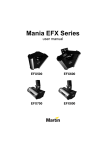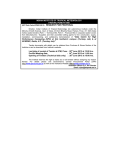Download Clearspan Cooldek Install
Transcript
INSTALLATION GUIDE Outback Clearspan Gable ® ® WITH COOLDEK ROOFING BEFORE YOU START It is important to check your Local Government Authority requirements before the installation of your new Stratco Outback® Clearspan Gable. It is the builder’s responsibility to ensure any existing structure that an Outback Clearspan Gable is being attached to is adequately reinforced to accommodate the additional loads imposed by the verandah, patio or carport. Read these instructions thoroughly before starting your project and refer to them constantly during each stage of construction. Contact Stratco for advice if you do not have the necessary tools or information. Before starting, lay out the main components in order of assembly on the ground and check them against the delivery note. The ‘Components’ section identifies each part of your Outback Clearspan Gable with Cooldek and shows the relative location of the components. Mark out the overall area of your verandah, patio or carport and ensure that it is free from obstructions. Beam to wall connections can cause difficulty if they coincide with door and window openings, so avoid these in your design. Ensure there is reasonable access for materials and working space and consider the disposal of run-off water. Check the column and beam positions on the ground; roughly check they are square by measuring the diagonals, then mark out the column locations. If columns are to be ‘in ground’, dig the holes to Stratco specifications. ADDITIONAL MATERIALS The Outback kit does not include fixings to attach the unit to an existing structure or concrete/masonry anchors for the column installation. Other items not included in the standard kit are infill panels and accessories, box gutters and cover flashings. If required, they must be purchased as additional items. ADDITIONAL MATERIALS • Drill • Post Hole Digger • Phillips Head Adaptors (5/16 & 3/8) • Spanner or Ratchet • Hex Head Adaptors (5/16 & 3/8) • Rivet Gun • Tape Measure • Tin Snips • Spirit Level • Hack-Saw • Silicone Gun • Adjustable Construction Props • Turn Up/Down Tool • Concrete • Ladder • Extended Drill bit COMPONENTS COOLDEK Insulated Roofing sheets COLUMNS Supports the beam framework. OUTBACK BEAMS The beams are the frame to support the roofing. BEAM IN-LINE CONNECTORS Joins beams flush to form a continuous beam. Different connections are available for various angles and loadings. BEAM FILLERS Fills gap between interesting beams. A notched version is available where a column also intersects. BEAM TO BEAM BRACKET Connects beams. TEK SCREWS with CYCLONE CAP AND NEOPRENE WASHER Used to fix insulted deck into beams. FOOTING PLATES 68 Outback Column Reinforced Footing Plate WALL BRACKET Fastens Outback beams directly to a wall. COOLDEK CLASSIC COOLDEK CGI POST BRACKET Connects post to beam SPACERS Are used to prevent the 150 attachment beam from crushing. POST CAP FIlls gap between the post and beam SCREWS AND RIVETS Fastener types vary depending upon the connection, ensure the correct fixings are used. DOWNPIPE Funnels water from the gutter to the ground via the outlet. Accessories of mitres, shoes and brackets are available as optional extras. GUTTER STRAP & STOP END RIDGE KNUCKLE Slots inside the gable rafters to form connection at the ridge. GABLE BEAM BRACKET Connects rafters to header beam. BEAM CAPPING Fixed to top of the valley beam to provide support for the Cooldek. 68 OUTBACK COLUMN WITH 50x50 SHS REINFORCED POST SHS POST CONNECTORS gutter strap Corner Connector Inline Connector gutte RAFTERS Gable rafters consist of pre-cut 120 Outback beam RAFTER TO VALLEY BRACKET Connects the rafter to the valley beam. receiving channel receiving channel SUSPENSION BRACKET Replaces the wall brackets when the beam is suspended from the fascia gutter riv flashing 4.8mm sealed rivets 68 Outback Column Footing Plate 4.8mm sealed rivets SHS Column Footing Plate receiving channel GUTTER The gutter adjoins the roof to catch water run off. Stop ends, outlets and straps are available. cutback flashing front gutter cutback flashing attach panel under sheet HEADER BEAM BRACKET Connects end strut to header beam on an infill gable. RIDGE CAP Covers the Cooldek at the gable ridge. BARGE CAP The barge cap covers the area where the deck finishes at the portal frame. HEADER FLASHING Runs along the header beam to neatly finish the base of the infill panels. END STRUT The gable infill is supported by the end strut, which consists of a section of post. 22O END STRUT PLATE Secures the end strut at the ridge PANEL STRIPS Decorative strips fixed to infill panels. INFILL PANEL Cut to suit gable end frames. RIDGE RAFTER BRACKET Cut to suit gable end frames. BEAM ENDCAP Encloses ends of beams. ANGLED CUTBACK FLASHING Flashing used to cover the deck at the gutter end. COMPONENT LAYOUT angled back channel ridge beam gable frame cooldek valley beam gutter header beam beam capping valley beam cutback flashing GABLE FRAME ASSEMBLY The first step when installing your Clearspan Ultimate with Cooldek is to assemble the gable frame. This will determine your gable opening which will be used when setting up the rest of the frame work. open gable rafter IMPORTANT: When assembling the gable frame ensure that the double thickness portion of the beams is on top and the seam is on the same side. The rafters are supplied pre-cut and drilled at the ridge. There are two types of rafters used depending on whether a header beam is being installed, these are shown in Figure 1.0. Insert the ridge knuckle into the pre-cut rafters and screw together infill gable rafter (header beam) using two 12x20 hex head self drilling screws through both sides of each rafter and two 12x20 hex head self drilling screws through the top (double flange side) of each rafter (figure 1.1). Make sure that the two ends are flush at the connection, leaving no gaps. Measure Figure 1.0 12 X 20 hex head self drilling screws ridge knuckle the distance between rafter ends, O, to check valley beam spacing (Figure 1.2). This will become the gable opening dimension. 12 X 20 hex head self drilling screws gable rafters gable opening (O) Figure 1.2 Figure 1.1 VALLEY BEAM ASSEMBLY Before erecting any valley beams the capping needs to be fixed to the top of the beams. The beam capping will support the Cooldek when it is laid and the gable brackets will be attached to the beam beam capping beam channel capping. When fixing the beam capping ensure that the double thickness of the beam is on top. Fix the beam channel to the top of the valley beam using 12x20 hex head self drilling screws at maximum 500mm centres and with two fix beam capping to channel using 3mm rivets each side at 500mm centres. Fix with two rivets either side at the location of a rafter. locate the break on the capping in top groove of valley beam screws at the location of all rafters as shown in figure 2.0. Fix the beam capping to the channel using 3mm rivets or 12x 20 hex head screws each side at maximum 500mm centres and with two rivets either side of the location of all rafters. Ensure the break is located in the top groove (figure 2.0). fix beam channel to top of valley beam using 12 x 20 hex head self drilling screws at 500mm centres. Fix channel with two screws at the location of a rafter. valley beam If attaching the valley beam to a header beam, notch the capping so that it sits on top of the header beam as shown in figure 6.6. Figure 2.0 ATTACHING ON SIDE TO HOUSE A Stratco Clearspan attached on its side to a house is attached to 60x44x2.0 G450 galvanised channel the existing eaves overhang at the fascia, or to an existing wall if height permits. The first objective in the construction is to fix a structural side beam rafter strengthening bracket along the fascia or wall, to which the Gable Unit is attached. Most existing houses have not been designed for the attachment of portal framed gables to their side, therefore additional strengthening of the house rafters must be performed. In order to strengthen the existing house rafters, the roof tiles or roof sheets need to be lifted to expose the roof frame. Steel rafter brackets and channels are then bolted along the house rafters. M12 bolt An attachment beam is bolted to the strengthening brackets at the fascia. Once the attachment beam is secured to the house, the Gable Unit can be erected and fastened to the beam. timber rafter The first step is to determine the number of rafters which need to Figure 3.0 be strengthened and their location relative to the unit. You will have to lift some roof tiles or roof sheets to discover the rafter positions and spacings. The number of rafters which need to be strengthened is determined by the builder, however spacing is recommended not to exceed 1200mm. Note: It is the builder’s responsibility to ensure the existing rafters and fascia are adequately reinforced and strengthened to accommodate any additional attached structure. The reinforcing method must be approved by the appropriate council or engineer. It is recommended an adjustable rafter strengthening bracket is used in conjunction with an extension channel, as shown in figure 3.0. The adjustable rafter strengthening bracket is shown in figure 3.1. Adjustable Rafter Strengthening Bracket Figure 3.1 RAFTER STRENGTHENING BRACKETS AND CHANNELS The adjustable rafter strengthening bracket allows for an adjustment to be fed through the front of the fascia. The hole may need to be of pitch in the range of 15 to 30 degrees. The distance the bracket enlarged slightly if the M12 cup head bolts interfere with the fascia. extends past the fascia is also adjustable to allow for standard Insert the bracket through the fascia and fix with the channel to the gutters or box gutters with a width of up to 200mm. house rafter using M12 hex head bolts through the existing holes In conjunction with rafter strengthening brackets a channel is fixed piece so it is horizontal and has the appropriate extension past the to the side of the house rafter (figure 3.0). The bottom end of fascia to allow for fixing of the attachment beam. T piece connection the channel will be located at the base of the house rafter. Holes bolts are to be tightened to a minimum 50Nm torque. in the bracket and further up the channel (Figure 4.3). Adjust the T should be marked and pre-drilled in the channel to suit the location of existing holes in the bracket. The channel will extend beyond Fix the bracket as close to the base of the gutter as possible the bracket so additional holes are to be drilled in the channel at (recommended distance 10mm from lowest end of gutter), as shown approximately 500mm centres. Initially the bracket T piece shall be in figure 4.1. fixed to the bracket arm with two M12 cup head bolts (hand tighten only), a spring washer is to be located between the standard M12 The attachment beam is to be fixed to the end plate to ensure the washer and nut (figure 4.0). Mark the position of the bracket on the roof sheets drain into the existing house gutter (figure 4.1). fascia and notch a rectangular hole in the fascia allowing the bracket cooldek roof sheet bracket arm enough clearence for roof sheets to run into house guttet t piece tighten to 50Nm torque M12 washer rafter M12 spring washer M12 cup head bolt rafter strengthening bracket M12 nut attachment beam fix bracket as close as possible to the base of the gutter Figure 4.0 we b ove Figure 4.1 recommended channel extension beyond birds mouth: 1900mm recommended web overhang: 400mm rha ng cha nn el ex ten sio n rafter strengthening bracket attached to rafter with 6 M12 hex head bolts timber rafter attachment beam fixed to rafter bracket with two M12 bolts channel gutter birds mouth rafter stud wall eaves overhang brick work attachment beam Figure 4.3 FIXING THE ATTACHMENT BEAM IN PLACE After fixing all the brackets and channels, the attachment beam can beam capping now be fixed into place. beam channel Prop the attachment beam in position with the beam capping on top, attachment beam allows clearance between the Cooldek and the gutter. Fix to the end rafter strengthening bracket the beam will need to be located at a height on the bracket which plates of the rafter bracket using two M12 bolts, with the bolt head on the attachment beam side. Insert spacers to prevent the beam from crushing, and bolt in position, using nuts and washers. To double flange spacer M12 bolt washer nut insert spacers drill 13mm holes through the attachment beam. Then drill 16mm holes on the outside face only, but this time do not drill all the way through. This will allow the spacer to slide in from the outside and stop at the other side as shown in figure 5. enlarged hole (16mm this side only) 13mm hole A cover flashing may be ordered as an additional option and custom Figure 5.0 made to cover the exposed brackets and holes through the fascia. Rivet flashings in place, figure 5.1 suggests a simplified flashing. The attachment beam becomes the base for the attachment of the house gutter Clearspan Gable unit. attachment beam Note: Do not over tighten bolts as this can lead to a visible indentation due to the high gloss nature of the material. Refer to figure 5.0 for fixing spacers. rivet fascia strengthening bracket rivet cover flashing (optional) Figure 5.1 END ATTACHED UNITS If fixing a Clearspan Gable on its end to a wall, valley beams are valley beam (beam cap on top) up into the wall bracket so the curved fixed directly to the wall using beam to wall brackets. The rear gable flange locate against the top flute of the beam. The valley beam is frame will need to be offset from the wall to allow the appropriate fastened to the wall bracket with two 12x20 hex head screws either bracket fixing. Wall brackets are positioned either side of the gable side in the pre-drilled holes while the opposite end is supported on opening at the spacing determined in the section ‘Gable Frame adjustable construction props. If required, additional hold down to Assembly’. The folded section on the tabs of the bracket is located the wall may be obtained by using tie down brackets, refer figure 6.1. at the top (figure 6.0). The highest point of the wall bracket will be 15mm below the top of the beam. Mark the holes and drill using A suspension bracket is used when a beam is suspended from an 8mm masonry bit. Fasten the bracket to the wall with two M8 the fascia (figure 6.3). If fixing a Clearspan Gable on its end with masonry anchors to a minimum 65mm embedment. Locate the first suspension brackets, the brackets are to be positioned either side of ridge beam wall Bracket beam capping 15mm wall bracket M10 bolt two 12x20 self- drilling screws on each side valley beam 50 x 2.0mm tie down bracket two M8 masonry anchors with minimum embedment of 65mm or two 8mm diameter screwbolts with a minimum embedment of 65mm three M8 masonry anchors or 8mm diameter screwbolts Recommended Bracket Length: N1, 0 ≤ 5100mm : 1200mm length N2, 0 ≤ 4200mm : 1200mm length all else: 1800mm length minimum edge distance of bolts and screws is (10 x dia) Figure 6.0 Figure 6.1 the gable opening. The gable rafter at the rear of the unit will need beam is fixed to rafter strengthening brackets as detailed in the to be set back sufficiently from the house fascia to accommodate previous section. Beam to beam brackets are positioned at either the house gutter and infill panel. Use silicone to seal behind the side of the gable opening at the spacing determined in Section ‘Gable suspension bracket and fascia. For steel fascia a minimum of three Frame Assembly’. Fix beam to beam brackets to the attachment M6 bolts with washers are fixed through the suspension bracket and beam (header beam) with two 12x20 hex head screws so they clamp fascia. For timber, three 12x25 type 17 screws are used to fix through the beam filler to the beam (figure 6.6). The first valley beam is the suspension bracket and timber. Refer figure 6.2 for fastener fastened over the beam to beam bracket with two 12x20 hex head locations. The first valley beam is slid into position and fastened screws either side while the opposite end is supported on adjustable using three 12x20 self drilling screws either side (figure 6.3), while construction props. the opposite end is supported on adjustable construction prop. Note: It is the builder’s responsibility to ensure the existing It is recommended extended fascia strengthening brackets and rafters and fascia are adequately reinforced and strengthened to reinforcing channels are fastened at a spacing not exceeding accommodate any additional attached structure. The reinforcing 1200mm centres to fascia and rafters (figure 6.3). Brackets are also method must be approved by the appropriate council or engineer. recommended to the first rafter either side of the valley beams. Secure brackets and channels to rafters with 12x25mm timber fixing screws through pre-drilled holes and bolt through fascia with M10 bolts. If required, additional fascia reinforcement may be obtained by securing RHS tubing behind the fascia, refer figure 6.4. If fixing a Clearspan Gable on its end to an attachment beam (figure 6.5), elevated to the existing house gutter height, the attachment extended fascia strengthening bracket (attach to rafter & reinforcing channel reinforcing channel fasteners; minimum 25mm spacing and minimum 10mm from any edge Figure 6.2 in- fill panel 120 gable rafter timber rafter 75 x 25 x 1.6 mm RHS soaker flashing gutter 50 x 1.6mm angle bracket two 12 gauge screws each leg beam capping soffit lining fascia M6 bolts and washers suspension bracket bolt through suspension bracket fascia and RHS reinforcement valley beam 12 x 20 hex head self drilling screws valley beam Figure 6.3 beam capping strengthening bracket attachment beam beam to beam bracket two 12x20 hex head self drilling screws attachment (header) beam house gutter fascia Figure 6.4 valley beam beam filler notched beam capping two 12x20 hex head self drilling screws through beam into bracket either side Figure 6.5 Figure 6.6 If any intermediate columns are required measure the valley beam Support the second valley beam on adjustable construction props section ‘68 Outback column’ or ‘SHS columns’. This can be done gable frame has been attached. COLUMN BRACKETS marking where they meet. Fasten post brackets as explained in the before the valley beams are fixed in place. but do not fix to the wall, fascia or attachment beam until the front BEAM TO BEAM CONNECTIONS For units where rear and/or front header beams are required beam to beam brackets will be used. Place the bracket on the inside face of the beam, aligning their curved flange with the top groove of the beam so that they clamp the beam fillers in place, fasten using two 12x20 hex head screws (figure 7.0). Fasten the incoming beam either side with two 12x20 self drilling screws (figure 7.1). curved flange beam bracket fits inside incoming beam beam bracket clamps over beam filler beam beam NOTE: BEAM CAPPING IS NOT SHOWN beam filler two 12x20 hex head screws two 12x20 hex head screws either side Figure 7.0 Figure 7.1 ATTACHING GABLE FRAME (WITHOUT HEADER BEAM) The rafter to valley brackets are attached to the beam capping on For a side attached unit support the second valley beam at the valley beams using six 12x20 hex head screws (figure 8.0) at the spacing determined in the section, ‘Gable Frame Assembly’ with For an end attached unit attach the second valley beam into the wall either side (figure 8.1). appropriate locations. or suspension bracket while using construction props to support the adjustable construction props. The gable rafters can now be fixed into the rafter to valley brackets with two 12x20 hex head screws opposite end. The gable rafters can now be fixed into the rafter to valley beam capping valley brackets with two 12x20 hex head screws either side (figure 8.1). 20 25 30 25 25 120 25 bracket position inline with the bottom edge of the upper groove 150 VALLEY BEAM WITH 22° RAFTER TO VALLEY BRACKET er raft bracket position inline with the bottom edge of the upper groove rafter to valley bracket two 12x20 hex head screws either side 120 VALLEY BEAM WITH 22° RAFTER TO VALLEY BRACKET valley beam Figure 8.0 Figure 8.1 ATTACHING GABLE FRAME (WITH HEADER BEAM) If the unit is being installed with header beam/s attach the beam to attach rafter to bracket using a minimum of 3 12x20 hex head self drilling screws each attach bracket using a side minimum of eight 12x20 hex head self drilling screws the frame work using beam to beam brackets. If fixed at the rear to an attachment beam this beam becomes the header beam. Attach gable beam brackets to the header beam and capping using a minimum of eight 12x20 hex head self drilling screws, refer figure 9.0. Rafters are supplied notched at the base to fit the gable beam brackets. Rafters are fastened inside the gable beam brackets with a minimum of three 12x20 hex head self drilling screws either side beam capping rafter header beam as shown in figure 9.0. gable beam bracket valley beam Figure 9.0 SOAKER FLASHING If rear infill panels are being used, a soaker flashing is used to conceal the existing house gutter, waterproof the rear end of the gable and neatly finish the base of the infill panel (figure 10.0). extended fascia strengthening bracket (attach to rafter & back channel infill panel 120 gable rafter soaker flashing gutter The rear gable frame and header beam are set back in order to beam capping accommodate the standard soaker flashing which is optional with the Outback unit. Fix the standard soaker flashing into position underneath the gutter. Infill panels must be fixed with split tail soft pull rivets at 500mm centres a minimum of 20mm above the pan of the soaker flashing. This will reduce the possibility of moisture being absorbed into soffit lining valley beam suspension bracket the sheet. Figure 10.0 REAR HEADER FLASHING When a gable is fixed at the rear to an attachment beam, elevated to beam capping infill panel the existing house gutter height, a header flashing is used typically header flashing in conjunction with the rear infill. In this case, the rear attachment split tail soft pull rivet beam is considered a header and along with the rear gable frame is fixed as close as possible (within 5mm) to the existing gutter in house gutter order to accommodate the header flashing. The gable frame is fixed on the rear header to gable beam brackets as previously described. Fix the header flashing into position over the existing gutter lip with rivets. Infill panels are located behind the header flashing and fixed with split tail soft pull rivets at 500mm centres (figure 11.0). fascia strengthening bracket 150 attachment beam valley beam Figure 11.0 ASSEMBLING RIDGE BEAM Fix the ridge rafter bracket at the ridge using six 12x20 hex head self fastened either side through the ridge rafter bracket at the ends of both ends of the unit. The base of the bracket is positioned 32mm frame and run 68mm past the end of the beam at both ends of the drilling screws through the gable frame and into the ridge knuckle at from the base of the gable frames, refer figure 12.0. If the ridge beam needs reinforcing, slide the c-section reinforcement inside the ridge beam and fix with 12x20 hex head self drilling screws at 500 centres through top flange and 1200mm centres through bottom flange, refer figure 12.1. Insert the ridge beam into the ridge rafter bracket and fix with a 12x 20 hex head self drilling screw on either side, refer figure 12.2. the ridge beam. The angled back channel must rest on the gable ridge beam. Fasten 12x20 hex head self drilling screws at 500mm centres along the double flange of the ridge beam (Figure 12.3). In the case of decking overhanging the gable frame, run the angled back channel to the end of the overhanging ridge beam as shown in figure 12.4. A ridge rafter bracket will be required at the front of the ridge to support the overhanging ridge beam. A maximum 600mm overhang is allowed. 12 x 20 hex head self drilling screws at 500 cts Fix angled back channel to both sides of the ridge beam using 12x20 hex head self drilling screws at 500mm centres, ensure a screw is ridge rafter bracket 6 12x 20 hex head screws into gable frame and ridge knuckle c- section reinforcement outback beam 32mm 12 x 20 hex head self drilling screws at 1200 cts position bracket 32mm from underside of gable frame Figure 12.0 Figure 12.1 12 x 20 hex head self drilling screws at 500mm centres along double flange of beam ridge beam angled back channel ridge rafter bracket 12 x 20 hex head screw on both sides into ridge beam ridge beam 12 x 20 hex head screw (at 500mm centres) through angled back channel into ridge beam ridge rafter bracket screw through back channel and ridge rafter bracket gable rafter angled back channel level with gable rafter gable rafter Figure 12.2 Figure 12.3 600mm of ridge overhang allowed. Run angled back channel to the end of the overhanging ridge beam ridge rafter bracket Figure 12.4 68 OUTBACK COLUMNS If using 68 Outback columns and fixing into the ground, dig the holes to the specified size and place a brick in the bottom of the hole (figure 13.1). At each post location, measure from the underside of the beam to the top of the brick and cut the columns to length. Check to ensure all columns are plumb. Reinforcing the 68 Outback Column If 50 x 50mm square hollow sections (SHS) have been supplied, the fluted 68 Outback columns will need to be reinforced. Cut two 12x35mm self drilling screws per side TOP 68 Outback column 50x50x3mm SHS B the 50mm SHS 75mm shorter than the column and slide into the and fix using two 12 x 35 hex head screws per side, at both ends, as detailed in figure 13.0. 68mm column. Ensure the section is aligned with the base of the column Post Brackets Fasten post brackets to the underside of beams at the relevent location with two 10x25 counter sunk self drilling screws either side. Slide the top of the 68 Outback column over the post bracket until it is flush with the underside of the valley beam. (Note: it may be 34mm B 68mm 30mm necessary to lift the fascia beam slightly to slide the column over the post bracket). The unfluted faces of the column should be aligned with each face of the post to beam bracket. Fasten the 68 Outback column to the post bracket using two 12x20 hex head screws either side as shown in figure 13.2. Use construction props or bracing to hold columns in position, but do not concrete in place at this stage. section B- B Figure 13.0 post cap beam bracket width column embedded minimum 450mm into concrete 10x25 counter sunk self drilling screws depth 12x20 hex head screws post bracket notched beam filler brick 12x20 hex head screws corbel Figure 13.1 Figure 13.2 SHS COLUMNS SHS corner connector If square hollow section (SHS) columns have been supplied, an alternative post to beam connection method is used. Measure from the underside of the beam to the top of the half brick and cut posts beam bracket SHS inline connector to this length at each post location. Screw the corner connector or inline connector to the top of the SHS post with two 12x20 hex head screws on either side of the column. Stand the post in position and 12 x 20 hex head screws screw the connector to both the outside face and underside of the beam with 12x20 hex head screws as shown in figure 14.0. Use construction props or bracing to hold columns in position, but 12 x 20 hex head screws 12 x 20 hex head screws do not concrete in place at this stage. SHS post SHS post Figure 14.0 FOOTING PLATES - 68 OUTBACK COLUMNS For non-reinforced 68 Outback Columns, two options of footing plate are available if fixing posts to an existing concrete slab, please familiarise yourself with the footing type being used before reading. External Footing If an external footing bracket is being used establish the column lengths by measuring the distance from the underside of the fascia beam to the concrete slab and deduct 20mm to allow for the depth screws are located at least 15mm from the top of the upstand with screws being a minimum 30mm apart. Internal Footing If an internal footing bracket is being used establish the column lengths by measuring the distance from the underside of the fascia beam to the concrete. Place the 5mm washer plate inside the footing upstand and fix to the concrete with one M12x75 masonry anchors of the footing bracket and cut the columns to length. Assemble the (minimum 75mm concrete edge distance). Measure the distance of the slots in the plate (figure 15.0). The upstand bracing must be mark this position on the column. Drill a 13mm hole at this location footing bracket and bracing into the bottom of the column, and and bolt through the column and the upstand with one M12 bolt footing bracket by sliding the legs of the footing upstand through located between the legs of the upstand. Slide the assembled fasten with two 12x20 hex head screws either side ensuring the top the holes on the side of the footing upstand from the ground and in the column. Slide the column over the internal footing upstand (figure 15.1). 30mm (minimum) M12 x 75 masonry anchors or screw bolts two 12x20 hex head screws either side upstand bracing M12 bolt with washer 5mm washer plate required footing plate internal footing upstand footing upstand minimum edge distance Figure 15.0 M12 x 75 masonry anchor or screw bolt minimum edge distance Figure 15.1 FOOTING PLATES - 68 REINFORCED OUTBACK COLUMNS Measure from the underside of the beams to the top of the footing 50mm SHS plate and cut the column to length. Refer section ‘68 Outback Columns’ for reinforcement details. Slide the SHS reinforced footing two 12 x 20mm hex head screws through both sides of column bracket into the bottom of the column, and fasten with two 12x20 hex head screws on either side of the post. Locate the top screws approximately 100mm from the base of the footing plate, and the 50mm SHS footing plate bottom screws 50mm from the base. This is shown in figure 16.0. 50mm 100mm Slide the top of the column over the installed post bracket and secure as previously indicated, refer section ‘68 Outback Columns’. Use construction props or bracing to hold columns in position but 50mm SHS footing plate fixed to slab using four M10 masonry anchors do not bolt to the concrete slab at this stage. Figure 16.0 FOOTING PLATES - SHS COLUMNS Measure from the underside of the beams to the top of the footing plate and cut column to length. Slide the SHS column footing bracket into the bottom of the column and fasten with two M10 two M10 bolts four M12 chemical anchors or equivalent bolts through the post. This is shown in figure 17.0. Fix corner or inline connectors to columns and fasten to beams as previously indicated, refer section ‘SHS Columns’. Use construction props or bracing to hold columns in position, but do not bolt to the concrete slab at this stage minimum edge distance minimum edge distance Figure 17.0 CAPPING To prevent moisture from entering the beams and for aesthetics, any beams with exposed ends require end caps to be fitted. Align the end cap and push into the exposed beam end (figure 18.0). If the postcap, align the two lugs with the two exposed holes of the post bracket and push firmly (figure 18.1). Outback columns are used, the postcaps can be fitted over the postbeam connection. Apply a small amount of silicone to the back of post bracket 68 outback column post cap silicone into bracket beam end caps Figure 18.0 Figure 18.1 FRAME WORK CHECK Check the framework is square by checking the diagonal measurements are equal. Figure 19.0 FIXING THE PANELS There are two types of profiles in the Cooldek range; Cooldek Classic and Cooldek CGI, refer figure below. The same procedure is used when fixing either option to the frame. for Classic and every second crest for CGI into the beam capping (and the flashing). If using 50mm Classic panels use 14x125mm hex head self drilling screws (14 x 150mm for 75mm Classic panels, 14 x 110 for 50mm CGI panels and 14 x 125 for 75mm CGI panels) COOLDEK CLASSIC refer figure 20.3. Pre-drill the crests of the ribs to provide clean holes for the seating COOLDEK CGI of neoprene washers. Use cyclone caps and neoprene washers for all crest fixing. Do not over tighten screws. Fix side laps with 12x20 hex head screws with neoprene washer at approximately 1000mm When attaching the Cooldek Sheeting, start from the rear on one centres. Silicone to waterproof all rivets. the angled back channel. Check the sheet is square against the Beam Capping End - WITHOUT A SIDE GUTTER the next sheet of decking over the previous sheets side lap and for Classic and every second crest for CGI into the beam capping. If side of the gable. Lift the first sheet into place and slide firmly into receiving channel and the beam capping and fix into position. Lay ensure that the slip joint of the two sheets has engaged, refer figure 20.0 and 20.1. Note: The minimum Cooldek sheet length is 2.0m. If your design requires sheets smaller than 2.0m they will be supplied at 2.0m and If no side gutter is being installed fix the decking through each crest using 50mm Classic panels use 14x125mm hex head self drilling screws (14 x 150mm for 75mm Classic panels, 14 x 110 for 50mm CGI panels and 14 x 125 for 75mm CGI panels), refer figure 20.4. Pre-drill the crests of the ribs to provide clean holes for the seating require cutting on site. of neoprene washers. Use cyclone caps and neoprene washers for all Ridge End hex head screws with neoprene washer at approx 1000mm centres. crest fixings. Do not over tighten screws. Fix side laps with 12 x 20 Sheeting is fastened to the angled back channel using 4.8mm sealed rivets to the underside of the sheeting at maximum 200mm centres and 12 x 20 hex head self drilling screws with neoprene washer from the top into each crest for the Classic profile and every third crest for CGI, refer figure 20.2. Beam Capping End - WITH A SIDE GUTTER When no side gutter is present a standard cutback flahsing will be used to protect the foam. Cutback the foam and the bottom skin of the insulated deck by 20mm. Position the cutback flashing as shown in figure 20.5 and rivet to the panel at 500mm centres from both sides. Silicone to waterproof all rivets. If a side gutter is being attached to the unit an ‘Angled Cutback side lap 12 x 20 hex head screw Flashing’ will need to be fixed to the ends of the sheeting. Cut back the foam and the bottom skin of the insulted deck to the beam capping, refer figure 20.3. Slide the angled cutback flashing between the beam capping and the sheeting. Rivet the cutback flashing to the top sheet at 1000mm centres and fix the decking through each crest beam capping CLASSIC slip joint 12 x 20 hex head screw side lap beam slip joint CGI Figure 20.1 12 x 20 hex head self drilling screw with neoprene washer through angled receiving channel receiving channel Figure 20.0 rivet angled cutback flashing to top sheet of panel 14 gauge hex head self drilling screw with cyclonic cap and neoprene washer. ridge beam decking angled cutback flahsing beam capping angled cutback flashing sits flush with beam capping. Foam and bottom skin of sheeting needs to be removed to here. rivet through receiving channel into decking at 200mm centres. Figure 20.2 Figure 20.3 decking 14 gauge hex head self drilling screw with cyclonic cap and neoprene washer rivet through top sheet and cutback flashing gable rafter beam capping cutback flashing sits 20mm back under top sheet. standard cutback flashing rivet through cutback flashing into panel Figure 20.4 Figure 20.5 SIDE GUTTER Attach the stop ends to the side gutters with four rivets per stop end, remove any swarf and waterproof with silicone. Lift the side gutter and rivet it to the top sheet and angled cutback flashing at 1000mm centres. Attach gutter straps to top sheet at maximum 1000mm centres, refer figure 21.0. Note: The gutter profile will look different if ‘Outback Gutter’ is used, see figure 21.2 for profile. 12 x 20 hex head self drilling screw with neoprene washer through gutter strap into top sheet When fixing gutters always ensure that the front face of the gutter remains vertical and even. All screws to have neoprene washers. Silicone to waterproof all rivets and any pan fixed screws. Gutter Outlet Position downpipe in line with column/s. Cut a hole in the base of the gutter near the back chamfer. Insert the gutter outlet pop from the inside of the gutter and rivet in place using 3mm rivets (figure rivet through gutter, cutback flashing and top sheet 21.1), remove any swarf and waterproof with silicone. rivet pop to gutter gutter gutter outlet (downpipe pop) gutter notched beam filler Figure 21.2 downpipe Figure 21.1 ed riv ets ch m se al 4.8m anne l 4.8m m se ack cutb d to eet vete p sh er ri and to tt u g g hin flas tter t gu fron ing rece iv ng ch aled s rivet trap er s gutt m 4.8m eivi CGI roofing sheets are being used then vermin proofing foam will anne l ridge capping gutt e r str ap The panels should be closed in order to protect against moisture and vermin. Use foam vermin proofing supplied see figure 22.0. If fix ridge cap to back channel with rivets at 250mm centers rivet s Position the ridge cap over the ridge beam and receiving channels and rivet into the channels at 250mm centres, refer figure 22.1. seal ed RIDGE CAPPING AND LOWER END CLOSURE gutt flas er rive te hin g an d to c u d to p sh tback eet gutt er s trap rive ted to c rest Figure 21.0 decking not be required. gable rafter foam vermin proofing Figure 22.0 Figure 22.1 Gable infill panels are to be cut in triangle shapes to fit the end spacings. Attach the header flashing to the underside of the header End struts are fixed mid-span of the header to a header beam infill panels. Refer figure 23.0 and 23.1. frame. Panels can be painted to the desired colour before installing. bracket at the base and an end strut plate at the ridge. Infill panels beam with 12x20 hex head screws to neatly finish the base of the fix to front of ridge with two 12x20 hex head self drilling screws are fixed through the top groove of rafters and the lower groove of the header beam with 8x35mm self embedding self drillingt screws at 500mm centres. Panels are fixed to the end strut at the same fix to strut with two 12x20 hex head self drilling screws either side infill panel header beam 12 x 20 hex head self drilling screws 8x35 self embedding screws header flashing fix bracket to header wiith two 12x20 hex head self drilling screws fix strut to bracket with two 12x20 hex head self drilling screws on either sides Figure 23.0 Figure 23.1 m se aled s rivet er s gutt trap er gutt l rivet barge cap to crest of decking at 500mm centres t fron anne the barge at the apex of the gable for a neat finish. Trim the barge at the gutter end to ensure a neat finish. 4.8m mitre end ng ch barge cap and rivet the top section to the deck as shown in figure 24.1. Mitre eivi Attach the barge cap by screwing the lower lip to the gable rafter ack cutb d to eet vete top sh er ri d gutt ing an h flas ATTACHING BARGE CAPPING mitred barge cap mitred barge cap barge cap gable rafter fix barge cap to gable rafter at front using 12x20 hex head self drilling screws trim barge cap for neat finish Figure 24.0 Figure 24.1 FINAL FIXING Fixing into the Concrete Footing Fixing onto Existing Concrete: External Footing post hole with approximately 150mm of concrete and use a shovel external footing plate, each plate must be fixed to the concrete. For this process until the hole is full, continually checking the posts column refer 25.3 and for an SHS column refer figure 25.2. The from the column to ensure any water does not pool around the 70mm for M10 anchors, 75mm for M12 anchors and 120mm for Thoroughly check the posts with a spirit level. When plumb, fill the or pole to agitate the concrete to remove any air pockets. Repeat as you go. The concrete must have a slight slope that runs away base (figure 25.0). Once the concrete is set remove any temporary bracing or props. If the columns are to be fixed to an existing concrete slab with an a 68 Outback Column refer figure 25.1, for a reinforced 68 Outback minimum distances from an anchor hole to the concrete edge is M16 anchors. Fixing onto Existing Concrete: Internal Footing Ensure the M12 bolt is tightened. Refer figure 25.4 Important Note Do not allow soil to remain in permanent contact with the columns, as corrosion will CONTACT 1300 165 165 result in the base of the column. Refer to the “Selection, Use and Maintenance of Stratco Steel Products” brochure for complete details of the maintenance requirements. Downpipes Before attaching the downpipes, rivet the downpipe brackets to the column and bend the flanges along the ‘break-line’ to accept the downpipe. Slide the downpipe over the gutter outlet and rivet into position. Rivet the downpipe to the brackets. Weatherproof all the fasteners with silicone. concrete raised up to column column M12x75 masonry anchors or M12x75 screwbolts Figure 25.0 footing plate SHS column four M12x75 masonry anchors Figure 25.1 footing plate Figure 25.2 68 Reinforced Outback Column M10 masonry anchors footing plate Figure 25.4 Figure 25.3 MAINTENANCE Regular maintenance is essential to maintain the good looks of all Stratco steel products and to ensure you receive the maximum life-span possible. Washing with clean water must be frequent enough to prevent the accumulation of dust, salts, and pollutants that may reduce the life of the product. Stratco steel products that are regularly washed by rain require no additional maintenance. No Stratco steel structure or materials are recommended for use over, or in close proximity, to swimming pools or spas. No material that retains water (such as dirt or paving sand) should be placed against the columns. Care must be taken when determining the location of Stratco steel products so that they © Copyright April 2012 All brands and logos/images accompanied by ® or ™ are trade marks of Stratco (Australia) Pty Limited. www.stratco.com.au are not placed in close contact with sources of pollution or environmental factors that could affect the life of the steel. Refer to the ‘Selection, Use and Maintenance’ brochure for more information.
















